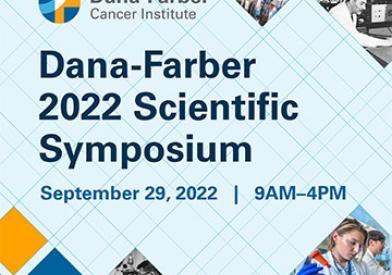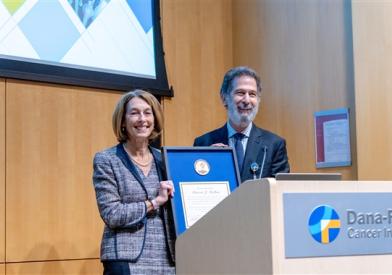
Barrett J. Rollins, MD, PhD
Contact Information
Office Phone Number
Fax
Appointments
Biography
Barrett J. Rollins, MD, PhD
After graduating from Amherst College, Dr. Rollins received his MD in 1979 and PhD in 1980 from Case Western Reserve University. He completed his internship and residency in internal medicine at Beth Israel Hospital, Boston. He then served a clinical fellowship in medical oncology at DFCI and a postdoctoral research fellowship with Dr. Charles Stiles. Since joining DFCI in 1989, Dr. Rollins has worked in the area of white blood cell trafficking and the interactions between inflammation and cancer.
Researcher
Physician
Recent Awards
- Scholar, Leukemia Society of America 1995
- American Society for Clinical Investigation 1996
- Association of American Physicians 2004
Research
Control of Leukocyte Migration by Chemokines
Leukocyte Trafficking
White blood cells are the first line of host defense against invaders from without (e.g., microbial pathogens) or within (e.g., tumors). To be effective, leukocytes must engage in complex trafficking patterns. Some travel to the site of the initial breach to fight the invasion nonspecifically. Others sample the invasion site and carry bits of information back to lymph nodes where they initiate an immune response that directs the migration of effector cells back to the invasion site. We now know that these movements are controlled by a family of small secreted proteins called chemokines.
One approach our laboratory takes to understanding chemokines is to study one in detail, namely monocyte chemoattractant protein-1 (MCP-1). We have dissected the molecular determinants of its function by structure-activity analyses and have attempted to understand its physiology using genetically modified mice. For example, studies in MCP-1-deficient mice show that this chemokine is essential for monocyte recruitment in inflammation, including diseases with inflammatory components such as atherosclerosis. We have also discovered that MCP-1 is required for the development of type 2 T helper cell-polarized immune responses, that is, those that fight parasites and are involved in allergies. Current efforts are directed toward understanding the molecular basis for this effect. We are also interested in the interface between chemokines and cancer. Chemokines can stimulate leukocytes to engage in host antitumor activity, but some chemokines can affect tumor cells directly. Recently, we demonstrated that ambient chemokines stimulate anti-apoptotic responses in tumor cells. In fact, some tumors secrete chemokines that act in an autocrine manner to inhibit apoptosis - a powerful and direct mechanism whereby inflammation can promote cancer.
Finally, a new area of research involves the Langerhans cell histiocytoses, a family of diseases in which chemokine abnormalities may play a role in determining patterns of organ involvement. We have demonstrated that pathologic Langerhans cells aberrantly express chemokine receptors in a manner that could explain patterns of tissue involvement in the histiocytoses.
Cell Cycle Control
In addition to leukocyte trafficking, our laboratory studies cell cycle control. In particular, we have demonstrated that cyclin C, an understudied regulator of the cell cycle, combines with cdk3 to promote exit from the G0 state by phosphorylation of pRb, the product of the retinoblastoma susceptibility gene. These new insights into the G0 resting state may have important implications for cancer treatment.
Research Website
https://rollinslab.dana-farber.orgPublications
-
MatchMiner: an open-source platform for cancer precision medicine. NPJ Precis Oncol. 2022 Oct 06; 6(1):69. View in: Pubmed
-
Histiocytosis. Lancet. 2021 07 10; 398(10295):157-170. View in: Pubmed
-
Genomic Characterization of de novo Metastatic Breast Cancer. Clin Cancer Res. 2021 02 15; 27(4):1105-1118. View in: Pubmed
-
The coming of age of Langerhans cell histiocytosis. Nat Immunol. 2020 01; 21(1):1-7. View in: Pubmed
-
BRAF V600E and Pten deletion in mice produces a histiocytic disorder with features of Langerhans cell histiocytosis. PLoS One. 2019; 14(9):e0222400. View in: Pubmed
-
Langerhans cell histiocytosis: progress and controversies. Br J Haematol. 2019 12; 187(5):559-562. View in: Pubmed
-
American Association for Cancer Research Project Genomics Evidence Neoplasia Information Exchange: From Inception to First Data Release and Beyond-Lessons Learned and Member Institutions' Perspectives. JCO Clin Cancer Inform. 2018 12; 2:1-14. View in: Pubmed
-
Histiocytoses: emerging neoplasia behind inflammation. Lancet Oncol. 2017 02; 18(2):e113-e125. View in: Pubmed
-
Institutional implementation of clinical tumor profiling on an unselected cancer population. JCI Insight. 2016 11 17; 1(19):e87062. View in: Pubmed
-
CCL2/CCR2 Regulates the Tumor Microenvironment in HER-2/neu-Driven Mammary Carcinomas in Mice. PLoS One. 2016; 11(11):e0165595. View in: Pubmed
-
Langerhans cell histiocytosis is a neoplasm and consequently its recurrence is a relapse: In memory of Bob Arceci. Pediatr Blood Cancer. 2016 10; 63(10):1704-12. View in: Pubmed
-
Revised classification of histiocytoses and neoplasms of the macrophage-dendritic cell lineages. Blood. 2016 06 02; 127(22):2672-81. View in: Pubmed
-
Brave-ish New World--What's Needed to Make Precision Oncology a Practical Reality. JAMA Oncol. 2015 Oct; 1(7):879-80. View in: Pubmed
-
Genomic Alterations in Langerhans Cell Histiocytosis. Hematol Oncol Clin North Am. 2015 Oct; 29(5):839-51. View in: Pubmed
-
Congenital and Acquired Disorders of Macrophages and Histiocytes. Hematol Oncol Clin North Am. 2015 Oct; 29(5):i. View in: Pubmed
-
Variable telomere length across post-mortem human brain regions and specific reduction in the hippocampus of major depressive disorder. Transl Psychiatry. 2015 Sep 15; 5:e636. View in: Pubmed
-
Dedication. Hematol Oncol Clin North Am. 2015 Oct; 29(5):xi-xii. View in: Pubmed
-
Congenital and Acquired Disorders of Macrophages and Histiocytes. Hematol Oncol Clin North Am. 2015 Oct; 29(5):xiii-xv. View in: Pubmed
-
Management and Outcome of Patients With Langerhans Cell Histiocytosis and Single-Bone CNS-Risk Lesions: A Multi-Institutional Retrospective Study. Pediatr Blood Cancer. 2015 Dec; 62(12):2162-6. View in: Pubmed
-
MAP2K1 and MAP3K1 mutations in Langerhans cell histiocytosis. Genes Chromosomes Cancer. 2015 Jun; 54(6):361-8. View in: Pubmed
-
Clinical implementation of integrated whole-genome copy number and mutation profiling for glioblastoma. Neuro Oncol. 2015 Oct; 17(10):1344-55. View in: Pubmed
-
Ethnicity, race, and socioeconomic status influence incidence of Langerhans cell histiocytosis. Pediatr Blood Cancer. 2015 Jun; 62(6):982-7. View in: Pubmed
-
Prospective enterprise-level molecular genotyping of a cohort of cancer patients. J Mol Diagn. 2014 Nov; 16(6):660-72. View in: Pubmed
-
Whole-exome sequencing and clinical interpretation of formalin-fixed, paraffin-embedded tumor samples to guide precision cancer medicine. Nat Med. 2014 Jun; 20(6):682-8. View in: Pubmed
-
Physicians' attitudes about multiplex tumor genomic testing. J Clin Oncol. 2014 May 01; 32(13):1317-23. View in: Pubmed
-
Somatic activating ARAF mutations in Langerhans cell histiocytosis. Blood. 2014 May 15; 123(20):3152-5. View in: Pubmed
-
Novel tumor suppressor function of glucocorticoid-induced TNF receptor GITR in multiple myeloma. PLoS One. 2013; 8(6):e66982. View in: Pubmed
-
BRAF V600E-Positive Multisite Langerhans Cell Histiocytosis in a Preterm Neonate. AJP Rep. 2013 Oct; 3(2):63-6. View in: Pubmed
-
Pathogenesis of Langerhans cell histiocytosis. Annu Rev Pathol. 2013 Jan 24; 8:1-20. View in: Pubmed
-
Recent advances in the understanding of Langerhans cell histiocytosis. Br J Haematol. 2012 Jan; 156(2):163-72. View in: Pubmed
-
Recurrent BRAF mutations in Langerhans cell histiocytosis. Blood. 2010 Sep 16; 116(11):1919-23. View in: Pubmed
-
The role of the CCL2/CCR2 axis in mouse mast cell migration in vitro and in vivo. J Immunol. 2010 Jun 01; 184(11):6114-23. View in: Pubmed
-
Where the confusion began: cloning the first chemokine receptors. J Immunol. 2009 Sep 01; 183(5):2893-4. View in: Pubmed
-
Langerhans cell histiocytosis: malignancy or inflammatory disorder doing a great job of imitating one? Dis Model Mech. 2009 Sep-Oct; 2(9-10):436-9. View in: Pubmed
-
RhoA and Rac1 GTPases play major and differential roles in stromal cell-derived factor-1-induced cell adhesion and chemotaxis in multiple myeloma. Blood. 2009 Jul 16; 114(3):619-29. View in: Pubmed
-
MicroRNAs 15a and 16 regulate tumor proliferation in multiple myeloma. Blood. 2009 Jun 25; 113(26):6669-80. View in: Pubmed
-
CXCR4 inhibitor AMD3100 disrupts the interaction of multiple myeloma cells with the bone marrow microenvironment and enhances their sensitivity to therapy. Blood. 2009 Apr 30; 113(18):4341-51. View in: Pubmed
-
microRNA expression in the biology, prognosis, and therapy of Waldenström macroglobulinemia. Blood. 2009 Apr 30; 113(18):4391-402. View in: Pubmed
-
Inhibition of MCP-1/CCR2 signaling does not inhibit intimal proliferation in a mouse aortic transplant model. J Vasc Res. 2008; 45(6):538-46. View in: Pubmed
-
Innocents abroad: regulating where naive T cells go. Nat Immunol. 2008 Mar; 9(3):233-5. View in: Pubmed
-
Monocyte chemoattractant protein-1 is a pathogenic component in a model for a hereditary peripheral neuropathy. Mol Cell Neurosci. 2008 Feb; 37(2):359-66. View in: Pubmed
-
Aggressive Langerhans cell histiocytosis following T-ALL: clonally related neoplasms with persistent expression of constitutively active NOTCH1. Am J Hematol. 2008 Feb; 83(2):116-21. View in: Pubmed
-
Absence of CC chemokine ligand 2 does not limit obesity-associated infiltration of macrophages into adipose tissue. Diabetes. 2007 Sep; 56(9):2242-50. View in: Pubmed
-
Critical role of monocyte chemoattractant protein-1/CC chemokine ligand 2 in the pathogenesis of ischemic cardiomyopathy. Circulation. 2007 Feb 06; 115(5):584-92. View in: Pubmed
-
Monocyte chemoattractant protein-1-induced tissue inflammation is critical for the development of renal injury but not type 2 diabetes in obese db/db mice. Diabetologia. 2007 Feb; 50(2):471-80. View in: Pubmed
-
The chemokine decoy receptor M3 blocks CC chemokine ligand 2 and CXC chemokine ligand 13 function in vivo. J Immunol. 2006 Nov 15; 177(10):7296-302. View in: Pubmed
-
Critical role of MCP-1 in the pathogenesis of experimental colitis in the context of immune and enterochromaffin cells. Am J Physiol Gastrointest Liver Physiol. 2006 Nov; 291(5):G803-11. View in: Pubmed
-
Release the hounds! A chemokine elicits monocytes from bone marrow. Nat Immunol. 2006 Mar; 7(3):230-2. View in: Pubmed
-
Monocyte recruitment in venous thrombus resolution. J Vasc Surg. 2006 Mar; 43(3):601-8. View in: Pubmed
-
Inflammatory chemokines in cancer growth and progression. Eur J Cancer. 2006 Apr; 42(6):760-7. View in: Pubmed
-
The chemokine CCL2 is required for control of murine gastric Salmonella enterica infection. Infect Immun. 2005 Oct; 73(10):6514-22. View in: Pubmed
-
CXC chemokine ligand 12 (stromal cell-derived factor 1 alpha) and CXCR4-dependent migration of CTLs toward melanoma cells in organotypic culture. J Immunol. 2005 May 01; 174(9):5856-63. View in: Pubmed
-
Chronic expression of monocyte chemoattractant protein-1 in the central nervous system causes delayed encephalopathy and impaired microglial function in mice. FASEB J. 2005 May; 19(7):761-72. View in: Pubmed
-
The effect of MCP-1 depletion on chemokine and chemokine-related gene expression: evidence for a complex network in acute inflammation. Cytokine. 2005 Apr 21; 30(2):64-71. View in: Pubmed
-
CCL2/Monocyte Chemoattractant Protein-1 regulates inflammatory responses critical to healing myocardial infarcts. Circ Res. 2005 Apr 29; 96(8):881-9. View in: Pubmed
-
Impairment in postischemic neovascularization in mice lacking the CXC chemokine receptor 3. Circ Res. 2005 Mar 18; 96(5):576-82. View in: Pubmed
-
Constitutive homing of mast cell progenitors to the intestine depends on autologous expression of the chemokine receptor CXCR2. Blood. 2005 Jun 01; 105(11):4308-13. View in: Pubmed
-
The CC chemokine ligand, CCL2/MCP1, participates in macrophage fusion and foreign body giant cell formation. Am J Pathol. 2004 Dec; 165(6):2157-66. View in: Pubmed
-
Differential roles of CCL2 and CCR2 in host defense to coronavirus infection. Virology. 2004 Nov 24; 329(2):251-60. View in: Pubmed
-
Aspergillus antigen induces robust Th2 cytokine production, inflammation, airway hyperreactivity and fibrosis in the absence of MCP-1 or CCR2. Respir Res. 2004 Sep 15; 5:12. View in: Pubmed
-
CCL2 (monocyte chemoattractant protein-1) and cancer. Semin Cancer Biol. 2004 Jun; 14(3):149-54. View in: Pubmed
-
Cyclin C/cdk3 promotes Rb-dependent G0 exit. Cell. 2004 Apr 16; 117(2):239-51. View in: Pubmed
-
MCP-1-dependent signaling in CCR2(-/-) aortic smooth muscle cells. J Leukoc Biol. 2004 Jun; 75(6):1079-85. View in: Pubmed
-
Chemokine-based pathogenetic mechanisms in cancer. Novartis Found Symp. 2004; 256:29-41; discussion 41-52, 266-9. View in: Pubmed
-
Chemokine influences on adaptive immunity and malignancies of the immune system. Ernst Schering Res Found Workshop. 2004; (45):11-30. View in: Pubmed
-
Blocking the monocyte chemoattractant protein-1/CCR2 chemokine pathway induces permanent survival of islet allografts through a programmed death-1 ligand-1-dependent mechanism. J Immunol. 2003 Dec 15; 171(12):6929-35. View in: Pubmed
-
Sequential MyD88-independent and -dependent activation of innate immune responses to intracellular bacterial infection. Immunity. 2003 Dec; 19(6):891-901. View in: Pubmed
-
Selective suppression of monocyte chemoattractant protein-1 expression by human papillomavirus E6 and E7 oncoproteins in human cervical epithelial and epidermal cells. Int J Cancer. 2003 Nov 10; 107(3):407-15. View in: Pubmed
-
MCP-1 deficiency is associated with reduced intimal hyperplasia after arterial injury. Biochem Biophys Res Commun. 2003 Oct 24; 310(3):936-42. View in: Pubmed
-
An animal model of age-related macular degeneration in senescent Ccl-2- or Ccr-2-deficient mice. Nat Med. 2003 Nov; 9(11):1390-7. View in: Pubmed
-
Post-BMT lung injury occurs independently of the expression of CCL2 or its receptor, CCR2, on host cells. Am J Physiol Lung Cell Mol Physiol. 2004 Feb; 286(2):L284-92. View in: Pubmed
-
CC chemokine ligand 2 and its receptor regulate mucosal production of IL-12 and TGF-beta in high dose oral tolerance. J Immunol. 2003 Oct 01; 171(7):3560-7. View in: Pubmed
-
DNA methyltransferase 3b contributes to oncogenic transformation induced by SV40T antigen and activated Ras. Oncogene. 2003 Jul 24; 22(30):4723-33. View in: Pubmed
-
Monocyte chemoattractant protein-1 (CCL2) in inflammatory disease and adaptive immunity: therapeutic opportunities and controversies. Microcirculation. 2003 Jun; 10(3-4):247-57. View in: Pubmed
-
Absence of CC chemokine ligand 2 results in an altered Th1/Th2 cytokine balance and failure to expel Trichuris muris infection. J Immunol. 2003 May 01; 170(9):4693-700. View in: Pubmed
-
Coincident expression of the chemokine receptors CCR6 and CCR7 by pathologic Langerhans cells in Langerhans cell histiocytosis. Blood. 2003 Apr 01; 101(7):2473-5. View in: Pubmed
-
Pertussis toxin-induced reversible encephalopathy dependent on monocyte chemoattractant protein-1 overexpression in mice. J Neurosci. 2002 Dec 15; 22(24):10633-42. View in: Pubmed
-
Regulation of cellular proliferation, cytoskeletal function, and signal transduction through CXCR4 and c-Kit in small cell lung cancer cells. Cancer Res. 2002 Nov 01; 62(21):6304-11. View in: Pubmed
-
Ccr2 regulates the level of MCP-1/CCL2 in vitro and at inflammatory sites and controls T cell activation in response to alloantigen. Cytokine. 2002 May 21; 18(4):184-90. View in: Pubmed
-
MCP-1 expression in endotoxin-induced uveitis. Invest Ophthalmol Vis Sci. 2002 May; 43(5):1493-8. View in: Pubmed
-
A functional IFN-gamma-inducible protein-10/CXCL10-specific receptor expressed by epithelial and endothelial cells that is neither CXCR3 nor glycosaminoglycan. J Immunol. 2001 Dec 01; 167(11):6576-82. View in: Pubmed
-
Inflammatory chemokine transport and presentation in HEV: a remote control mechanism for monocyte recruitment to lymph nodes in inflamed tissues. J Exp Med. 2001 Nov 05; 194(9):1361-73. View in: Pubmed
-
Chemokines and atherosclerosis: what Adam Smith has to say about vascular disease. J Clin Invest. 2001 Nov; 108(9):1269-71. View in: Pubmed
-
Wound healing in MIP-1alpha(-/-) and MCP-1(-/-) mice. Am J Pathol. 2001 Aug; 159(2):457-63. View in: Pubmed
-
A phase II trial of the cyclin-dependent kinase inhibitor flavopiridol in patients with previously untreated stage IV non-small cell lung cancer. Clin Cancer Res. 2001 Jun; 7(6):1590-9. View in: Pubmed
-
If it's Tuesday, this must be a Belgian chemokine. Blood. 2001 Apr 15; 97(8):2193. View in: Pubmed
-
Absence of monocyte chemoattractant protein 1 in mice leads to decreased local macrophage recruitment and antigen-specific T helper cell type 1 immune response in experimental autoimmune encephalomyelitis. J Exp Med. 2001 Mar 19; 193(6):713-26. View in: Pubmed
-
Chemokines and disease. Nat Immunol. 2001 Feb; 2(2):108-15. View in: Pubmed
-
Control of TH2 polarization by the chemokine monocyte chemoattractant protein-1. Nature. 2000 Mar 23; 404(6776):407-11. View in: Pubmed
-
The physiology of p16(INK4A)-mediated G1 proliferative arrest. Cell Biochem Biophys. 2000; 33(2):189-97. View in: Pubmed
-
Targeted expression of chemokines in vivo. Methods Mol Biol. 2000; 138:243-51. View in: Pubmed
-
Monocyte chemoattractant protein 1-dependent leukocytic infiltrates are responsible for autoimmune disease in MRL-Fas(lpr) mice. J Exp Med. 1999 Dec 20; 190(12):1813-24. View in: Pubmed
-
Flavopiridol induces cell cycle arrest and p53-independent apoptosis in non-small cell lung cancer cell lines. Clin Cancer Res. 1999 Oct; 5(10):2925-38. View in: Pubmed
-
Physiological coreceptor use by dual-tropic HIV-1: one plus one equals one. J Clin Invest. 1999 Sep; 104(5):531-2. View in: Pubmed
-
Mice deficient in tumor necrosis factor-alpha are resistant to skin carcinogenesis. Nat Med. 1999 Jul; 5(7):828-31. View in: Pubmed
-
Monocyte chemoattractant protein-1 accelerates atherosclerosis in apolipoprotein E-deficient mice. Arterioscler Thromb Vasc Biol. 1999 Jun; 19(6):1518-25. View in: Pubmed
-
MCP-1 deficiency reduces susceptibility to atherosclerosis in mice that overexpress human apolipoprotein B. J Clin Invest. 1999 Mar; 103(6):773-8. View in: Pubmed
-
Expression of the focal adhesion protein paxillin in lung cancer and its relation to cell motility. Oncogene. 1999 Jan 07; 18(1):67-77. View in: Pubmed
-
Monocyte chemoattractant protein-1. Chem Immunol. 1999; 72:7-29. View in: Pubmed
-
Monocyte chemoattractant protein-1 promotes macrophage-mediated tubular injury, but not glomerular injury, in nephrotoxic serum nephritis. J Clin Invest. 1999 Jan; 103(1):73-80. View in: Pubmed
-
Absence of monocyte chemoattractant protein-1 reduces atherosclerosis in low density lipoprotein receptor-deficient mice. Mol Cell. 1998 Aug; 2(2):275-81. View in: Pubmed
-
Abnormalities in monocyte recruitment and cytokine expression in monocyte chemoattractant protein 1-deficient mice. J Exp Med. 1998 Feb 16; 187(4):601-8. View in: Pubmed
-
p16INK4A participates in a G1 arrest checkpoint in response to DNA damage. Mol Cell Biol. 1998 Jan; 18(1):378-87. View in: Pubmed
-
Tissue factor is induced by monocyte chemoattractant protein-1 in human aortic smooth muscle and THP-1 cells. J Biol Chem. 1997 Nov 07; 272(45):28568-73. View in: Pubmed
-
In vivo properties of monocyte chemoattractant protein-1. J Leukoc Biol. 1997 Nov; 62(5):577-80. View in: Pubmed
-
Mutation analysis of glial cell line-derived neurotrophic factor, a ligand for an RET/coreceptor complex, in multiple endocrine neoplasia type 2 and sporadic neuroendocrine tumors. J Clin Endocrinol Metab. 1997 Sep; 82(9):3025-8. View in: Pubmed
-
Chemokines. Blood. 1997 Aug 01; 90(3):909-28. View in: Pubmed
-
Transgenic monocyte chemoattractant protein-1 (MCP-1) in pancreatic islets produces monocyte-rich insulitis without diabetes: abrogation by a second transgene expressing systemic MCP-1. J Immunol. 1997 Jul 01; 159(1):401-8. View in: Pubmed
-
Renal expression of monocyte chemoattractant protein-1 in lupus autoimmune mice. J Am Soc Nephrol. 1997 May; 8(5):720-9. View in: Pubmed
-
MCP-1-mediated chemotaxis requires activation of non-overlapping signal transduction pathways. J Leukoc Biol. 1997 Apr; 61(4):529-32. View in: Pubmed
-
Human fibroblasts express functional IL-2 receptors formed by the IL-2R alpha- and beta-chain subunits: association of IL-2 binding with secretion of the monocyte chemoattractant protein-1. J Immunol. 1996 Jul 15; 157(2):851-7. View in: Pubmed
-
The beta-chemokine receptors CCR3 and CCR5 facilitate infection by primary HIV-1 isolates. Cell. 1996 Jun 28; 85(7):1135-48. View in: Pubmed
-
Monocyte chemoattractant protein 1: a potential regulator of monocyte recruitment in inflammatory disease. Mol Med Today. 1996 May; 2(5):198-204. View in: Pubmed
-
p16INK4A as a human tumor suppressor. Biochim Biophys Acta. 1996 Mar 18; 1242(3):165-9. View in: Pubmed
-
High level expression of human MCP-1 using the LCR/MEL expression system. Protein Expr Purif. 1996 Mar; 7(2):173-82. View in: Pubmed
-
Multiple mechanisms of p16INK4A inactivation in non-small cell lung cancer cell lines. Cancer Res. 1995 Dec 15; 55(24):6200-9. View in: Pubmed
-
High level monocyte chemoattractant protein-1 expression in transgenic mice increases their susceptibility to intracellular pathogens. J Immunol. 1995 Nov 15; 155(10):4838-43. View in: Pubmed
-
Monocyte chemoattractant protein-1 (MCP-1) gene transduction: an effective tumor vaccine strategy for non-intracranial tumors. Cancer Immunol Immunother. 1995 Oct; 41(4):227-35. View in: Pubmed
-
A dominant negative inhibitor indicates that monocyte chemoattractant protein 1 functions as a dimer. Mol Cell Biol. 1995 Sep; 15(9):4851-5. View in: Pubmed
-
A novel p16INK4A transcript. Cancer Res. 1995 Jul 15; 55(14):2995-7. View in: Pubmed
-
Reciprocal Rb inactivation and p16INK4 expression in primary lung cancers and cell lines. Cancer Res. 1995 Feb 01; 55(3):505-9. View in: Pubmed
-
Serologic analysis of the mouse beta chemokine JE/monocyte chemoattractant protein-1. J Immunol. 1994 Oct 15; 153(8):3708-16. View in: Pubmed
-
Monocyte chemoattractant protein-1 gene is expressed in activated neutrophils and retinoic acid-induced human myeloid cell lines. Blood. 1994 Oct 15; 84(8):2776-83. View in: Pubmed
-
Structure/activity analysis of human monocyte chemoattractant protein-1 (MCP-1) by mutagenesis. Identification of a mutated protein that inhibits MCP-1-mediated monocyte chemotaxis. J Biol Chem. 1994 Jun 03; 269(22):15918-24. View in: Pubmed
-
Biochemical and biologic characterization of murine monocyte chemoattractant protein-1. Identification of two functional domains. J Immunol. 1994 Apr 01; 152(7):3541-9. View in: Pubmed
-
MCP-1 expression by rat type II alveolar epithelial cells in primary culture. J Immunol. 1993 May 15; 150(10):4561-70. View in: Pubmed
-
"Oh, no. Not another cytokine."--MCP-1 and respiratory disease. Am J Respir Cell Mol Biol. 1992 Aug; 7(2):126-7. View in: Pubmed
-
JE mRNA accumulates rapidly in aortic injury and in platelet-derived growth factor-stimulated vascular smooth muscle cells. Circ Res. 1992 Feb; 70(2):314-25. View in: Pubmed
-
Expression of cytokine-like genes JE and KC is increased during renal ischemia. Am J Physiol. 1991 Dec; 261(6 Pt 2):F1095-101. View in: Pubmed
-
JE/MCP-1: an early-response gene encodes a monocyte-specific cytokine. Cancer Cells. 1991 Dec; 3(12):517-24. View in: Pubmed
-
In vivo and in vitro inhibition of JE gene expression by glucocorticoids. J Biol Chem. 1991 Nov 25; 266(33):22375-9. View in: Pubmed
-
Human keratinocyte growth-promoting activity on the surface of fibroblasts. J Cell Physiol. 1991 Oct; 149(1):110-6. View in: Pubmed
-
Recombinant human MCP-1/JE induces chemotaxis, calcium flux, and the respiratory burst in human monocytes. Blood. 1991 Aug 15; 78(4):1112-6. View in: Pubmed
-
Interleukin-4 induces the synthesis and secretion of MCP-1/JE by human endothelial cells. Am J Pathol. 1991 Jun; 138(6):1315-9. View in: Pubmed
-
Monocyte chemotactic protein gene expression by cytokine-treated human retinal pigment epithelial cells. Lab Invest. 1991 Jun; 64(6):819-25. View in: Pubmed
-
Suppression of tumor formation in vivo by expression of the JE gene in malignant cells. Mol Cell Biol. 1991 Jun; 11(6):3125-31. View in: Pubmed
-
Assignment of the human small inducible cytokine A2 gene, SCYA2 (encoding JE or MCP-1), to 17q11.2-12: evolutionary relatedness of cytokines clustered at the same locus. Genomics. 1991 Jun; 10(2):489-92. View in: Pubmed
-
Alveolar macrophage-derived cytokines induce monocyte chemoattractant protein-1 expression from human pulmonary type II-like epithelial cells. J Biol Chem. 1991 May 25; 266(15):9912-8. View in: Pubmed
-
Cytokine-activated human endothelial cells synthesize and secrete a monocyte chemoattractant, MCP-1/JE. Am J Pathol. 1990 Jun; 136(6):1229-33. View in: Pubmed
-
The human homolog of the JE gene encodes a monocyte secretory protein. Mol Cell Biol. 1989 Nov; 9(11):4687-95. View in: Pubmed
-
Environment-dependent growth inhibition of human epidermal keratinocytes by recombinant human transforming growth factor-beta. J Cell Physiol. 1989 Jun; 139(3):455-62. View in: Pubmed
-
Evidence for a novel signal transduction pathway activated by platelet-derived growth factor and by double-stranded RNA. Mol Cell Biol. 1989 Apr; 9(4):1705-13. View in: Pubmed
-
Serum-inducible genes. Adv Cancer Res. 1989; 53:1-32. View in: Pubmed
-
Platelet-derived growth factor regulates glucose transporter expression. J Biol Chem. 1988 Nov 15; 263(32):16523-6. View in: Pubmed
-
Comparison of fibroblast and T-cell activation genes. Cell Immunol. 1988 Sep; 115(2):481-3. View in: Pubmed
-
Association of food frequency questionnaire estimates of vitamin A intake with serum vitamin A levels. Am J Epidemiol. 1988 Sep; 128(3):645-54. View in: Pubmed
-
Cloning and expression of JE, a gene inducible by platelet-derived growth factor and whose product has cytokine-like properties. Proc Natl Acad Sci U S A. 1988 Jun; 85(11):3738-42. View in: Pubmed
-
Regulation of c-myc and c-fos proto-oncogene expression by animal cell growth factors. In Vitro Cell Dev Biol. 1988 Feb; 24(2):81-4. View in: Pubmed
-
Molecular regulation of growth control: implications for wound healing. Prog Clin Biol Res. 1988; 266:19-22. View in: Pubmed
-
Platelet-derived growth factor generates at least two distinct intracellular signals that modulate gene expression. Cold Spring Harb Symp Quant Biol. 1988; 53 Pt 1:531-6. View in: Pubmed
-
A cell-cycle constraint on the regulation of gene expression by platelet-derived growth factor. Science. 1987 Nov 27; 238(4831):1269-71. View in: Pubmed
-
Differential colony hybridization: molecular cloning from a zero data base. Methods Enzymol. 1987; 147:64-85. View in: Pubmed
-
Preliminary characterization of the proteoglycans in the substrate adhesion sites of normal and virus-transformed murine cells. Biochemistry. 1979 Dec 11; 18(25):5621-9. View in: Pubmed
-
Fibronectin and proteoglycans as determinants of cell-substratum adhesion. J Supramol Struct. 1979; 11(3):401-27. View in: Pubmed
-
Two functionally distinct pools of glycosaminoglycan in the substrate adhesion site of murine cells. J Cell Biol. 1978 Dec; 79(3):788-801. View in: Pubmed
Locations

Dana-Farber Cancer Institute
450 Brookline Avenue Smith 758 Boston, MA 02215Dana-Farber Cancer Institute




